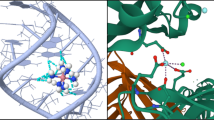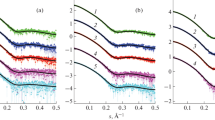Abstract
Globular proteins play several essential roles in functioning different mechanisms of the living organisms, and the stability of such protein molecules in an aqueous solution is strongly affected by multivalent ions. In this article, we have systematically studied the effect of temperature (between 5 and 25ºC) on the re-entrant condensation behaviour of bovine serum albumin (BSA) in the presence of trivalent ions, Yttrium (Y3+), and Lanthanum (La3+). The effect of temperature is explained considering the optical properties of the protein, i.e., from the optical absorption and emission behaviours. The absorption in the visible region and the fluorescence emission of BSA becomes maximum at the lowest temperature. The decrement of mobility at lower temperature is responsible for fluorescence enhancement. Moreover, the activation energy of the turbid or viscus phase of the BSA protein under re-entrant condensation is enhanced in comparison with the transparent phase and the corresponding energy value is estimated from the fluorescence study.





Similar content being viewed by others
Availability of Data and Material
Not applicable.
Code Availability
Not Applicable.
References
Whitford D (2005) Protein: Structure and Function. John Wiley & Sons Ltd., England
Keskin O, Gursoy A, Ma B, Nussinov R (2008) Principles of Protein−Protein Interactions: What are the Preferred Ways For Proteins To Interact? Chem Rev 108:1225–1244. https://doi.org/10.1021/cr040409x
Chan HS, Dill KA (1990) Origins of structure in globular proteins. Proc Nati Acad Sci 87:6388–6392. https://doi.org/10.1073/pnas.87.16.6388
Bucciarelli S, Casal-Dujat L, Michele CD, Sciortino F, Dhont J, Bergenholtz J, Farago B, Schurtenberger P, Stradner A (2015) Unusual Dynamics of Concentration Fluctuations in Solutions of Weakly Attractive Globular Proteins. J Phys Chem Lett 6:4470–4474. https://doi.org/10.1021/acs.jpclett.5b02092
Barbosa LRS, Ortore MG, Spinozzi F, Mariani P, Bernstorff S, Itri R (2010) The Importance of Protein-Protein Interactions on the pH-Induced Conformational Changes of Bovine Serum Albumin: A Small-Angle X-Ray Scattering Study. Biophys J 98:147–157. https://doi.org/10.1016/j.bpj.2009.09.056
Kundu S, Pandit S, Abbas S, Aswal VK, Kohlbrecher J (2018) Structures and interactions among globular proteins above the isoelectric point in the presence of divalent ions: A small angle neutron scattering and dynamic light scattering study. Chem Phys Lett 693:176–182. https://doi.org/10.1016/j.cplett.2018.01.022
Matsarskaia O, Braun MK, Roosen-Runge F, Wolf M, Zhang F, Roth R, Schreiber F (2016) Cation-Induced Hydration Effects Cause Lower Critical Solution Temperature Behavior in Protein Solutions. J Phys Chem B 120:7731–7736. https://doi.org/10.1021/acs.jpcb.6b04506
Baglioni P, Fratini E, Lonetti B, Chen SH (2004) Structural arrest in concentrated cytochrome C solutions: the effect of pH and salts. J. Phys.: Condens. Matter 16:S5003–S5022. https://doi.org/10.1088/0953-8984/16/42/016
Pasquier C, Vazdar M, Forsman J, Jungwirth P, Lund M (2017) Anomalous Protein−Protein Interactions in Multivalent Salt Solution. J Phys Chem B 121:3000–3006. https://doi.org/10.1021/acs.jpcb.7b01051
Hansen J, Platten F, Wagner D, Egelhaaf SU (2016) Tuning protein–protein interactions using cosolvents: specific effects of ionic and non-ionic additives on protein phase behavior. Phys Chem Chem Phys 18:10270–10280. https://doi.org/10.1039/c5cp07285a
Matsarskaia O, Roosen-Runge F, Schreiber F (2020) Multivalent ions and biomolecules: Attempting a comprehensive perspective. ChemPhysChem 21:1742–1767. https://doi.org/10.1002/cphc.202000162
Zhou HX, Pang X (2018) Electrostatic Interactions in Protein Structure, Folding, Binding, and Condensation. Chem Rev 118:1691–1741. https://doi.org/10.1021/acs.chemrev.7b00305
Roberts D, Keeling R, Tracka M, van der Walle CF, Uddin S, Warwicker J, Curtis R (2014) The Role of Electrostatics in Protein−Protein Interactions of a Monoclonal Antibody. Mol Pharmaceutics 11:2475–2489. https://doi.org/10.1021/mp5002334
Braun MK, Wolf M, Matsarskaia O, Vela SD, Roosen-Runge F, Sztucki M, Roth R, Zhang F, Schreiber F (2017) Strong Isotope Effects on Effective Interactions and Phase Behavior in Protein Solutions in the Presence of Multivalent Ions. J Phys Chem B 121:1731–1739. https://doi.org/10.1021/acs.jpcb.6b12814
Schubert R, Meyer A, Baitan D, Dierks K, Perbandt M, Betzel C (2017) Real-Time Observation of Protein Dense Liquid Cluster Evolution during Nucleation in Protein Crystallization. Cryst Growth Des 17:954–958. https://doi.org/10.1021/acs.cgd.6b01826
Pliss A, Levchenko SM, Liu L, Peng X, Ohulchanskyy TY, Roy I, Kuzmin AN, Qu J, Prasad PN (2019) Cycles of protein condensation and discharge in nuclear organelles studied by fluorescence lifetime imaging. Nat Commun 10:455. https://doi.org/10.1038/s41467-019-08354-3
Sauter A, Zhang F, Szekely NK, Pipich V, Sztucki M, Schreiber F (2016) Structural Evolution of Metastable Protein Aggregates in the Presence of Trivalent Salt Studied by (V)SANS and SAXS. J Phys Chem B 120:5564–5571. https://doi.org/10.1021/acs.jpcb.6b03559
Vela SD, Begam N, Dyachok D, Schaufele RS, Matsarskai O, Braun MK, Girelli A, Ragulskaya A, Mariani A, Zhang F, Schreiber F (2020) Interplay between Glass Formation and Liquid−Liquid Phase Separation Revealed by the Scattering Invariant. J Phys Chem Lett 11:7273–7278. https://doi.org/10.1021/acs.jpclett.0c02110
Dignon GL, Zheng W, Kim YC, Mittal J (2019) Temperature-Controlled Liquid−Liquid Phase Separation of Disordered Proteins. ACS Cent Sci 5:821–830. https://doi.org/10.1021/acscentsci.9b00102
Roosen-Runge F, Heck BS, Zhang F, Kohlbacher O, Schreiber F (2013) Interplay of pH and Binding of Multivalent Metal Ions: Charge Inversion and Reentrant Condensation in Protein Solutions. J Phys Chem B 117:5777–5787. https://doi.org/10.1021/jp401874t
Braun MK, Sauter A, Matsarskaia O, Wolf M, Roosen-Runge F, Sztucki M, Roth R, Zhang F, Schreiber F (2018) Reentrant Phase Behavior in Protein Solutions Induced by Multivalent Salts: Strong Effect of Anions Cl− Versus NO3−. J Phys Chem B 122:11978–11985. https://doi.org/10.1021/acs.jpcb.8b10268
Zhang F, Roosen-Runge F, Sauter A, Wolf M, Jacobs RMJ, Schreiber F (2014) Reentrant condensation, liquid–liquid phase separation and crystallization in protein solutions induced by multivalent metal ions. Pure Appl Chem 86:191–202. https://doi.org/10.1515/pac-2014-5002
Matsarskaia O, Vela SD, Mariani A, Fu Z, Zhang F, Schreiber F (2019) Phase-Separation Kinetics in Protein−Salt Mixtures with Compositionally Tuned Interactions. J Phys Chem B 123:1913–1919. https://doi.org/10.1021/acs.jpcb.8b10725
Zhang F, Skoda MWA, Jacobs RMJ, Zorn S, Martin RA, Martin CM, Clark GF, Weggler S, Hildebrandt A, Kohlbacher O, Schreiber F (2008) Reentrant Condensation of Proteins in Solution Induced by Multivalent Counterions. Phys Rev Lett 101:148101. https://doi.org/10.1103/PhysRevLett.101.148101
Jordan E, Roosen-Runge F, Leibfarth S, Zhang F, Sztucki M, Hildebrandt A, Kohlbacher O, Schreiber F (2014) Competing Salt Effects on Phase Behavior of Protein Solutions: Tailoring of Protein Interaction by the Binding of Multivalent Ions and Charge Screening. J Phys Chem B 118:11365–11374. https://doi.org/10.1021/jp5058622
Babu MM, van der Lee R, de Groot NS, Gsponer J (2011) Intrinsically disordered proteins: regulation and disease. Curr Opin Struct Biol 21:432–440. https://doi.org/10.1016/j.sbi.2011.03.011
Uversky VN, Dave V, Iakoucheva LM, Malaney P, Metallo SJ, Pathak RR, Joerger AC (2014) Pathological Unfoldomics of Uncontrolled Chaos: Intrinsically Disordered Proteins and Human Diseases. Chem Rev 114:6844–6879. https://doi.org/10.1021/cr400713r
Cheng C, Jia J, Ran S (2015) Polyethylene glycol and divalent salt-induced DNA reentrant condensation revealed by single molecule measurements. Soft Matter 11:3927–3935. https://doi.org/10.1039/c5sm00619h
Nguyen TT, Rouzina I, Shklovskii BI (2000) Reentrant condensation of DNA induced by multivalent counterions. J Chem Phys 112:2562. https://doi.org/10.1063/1.480819
Butler JC, Angelini T, Tang JX, Wong GCL (2003) Ion Multivalence and Like-Charge Polyelectrolyte Attraction. Phys Rev Lett 91:028301. https://doi.org/10.1103/PhysRevLett.91.028301
Zhang F, Weggler S, Ziller MJ, Ianeselli L, Heck BS, Hildebrandt A, Kohlbacher O, Skoda MWA, Jacobs RMJ, Schreiber F (2010) Universality of protein reentrant condensation in solution induced by multivalent metal ions. Proteins 78:3450–3457. https://doi.org/10.1002/prot.22852
Roosen-Runge F, Zhang F, Schreiber F, Roth R (2014) Ion-activated attractive patches as a mechanism for controlled protein interactions. Sci Rep 4:7016. https://doi.org/10.1038/srep07016
Fries MR, Stopper D, Braun MK, Hinderhofer A, Zhang F, Jacobs RMJ, Skoda MWA, Hansen-Goos H, Roth R, Schreiber F (2017) Multivalent-Ion-Activated Protein Adsorption Reflecting Bulk Reentrant Behavior. Phys Rev Lett 119:228001. https://doi.org/10.1103/PhysRevLett.119.228001
Kumar S, Yadav I, Ray D, Abbas S, Saha D, Aswal VK, Kohlbrecher J (2019) Evolution of Interactions in the Protein Solution As Induced by Mono and Multivalent Ions. Biomacromol 20:2123–2134. https://doi.org/10.1021/acs.biomac.9b00374
Mamontov E, O’Neill H (2014) Reentrant Condensation of Lysozyme: Implications for Studying Dynamics of Lysozyme in Aqueous Solutions of Lithium Chloride. Biopolymers 101:624–629. https://doi.org/10.1002/bip.22430
Zhang F, Roth R, Wolf M, Roosen-Runge F, Skoda MWA, Jacobs RMJ, Stzuckie M, Schreiber F (2012) Charge-controlled metastable liquid–liquid phase separation in protein solutions as a universal pathway towards crystallization. Soft Matter 8:1313–1316. https://doi.org/10.1039/c2sm07008a
Fries MR, Conzelmann NF, Günter L, Matsarskaia O, Skoda MWA, Jacobs RMJ, Zhang F, Schreiber F (2021) Bulk Phase Behavior vs Interface Adsorption: Specific Multivalent Cation and Anion Effects on BSA Interactions. Langmuir 37:139–150. https://doi.org/10.1021/acs.langmuir.0c02618
Begam N, Matsarskaia O, Sztucki M, Zhang F, Schreiber F (2020) Unification of lower and upper critical solution temperature phase behavior of globular protein solutions in the presence of multivalent cations. Soft Matter 16:2128–2134. https://doi.org/10.1039/c9sm02329a
Vela SD, Braun MK, Dorr A, Greco A, Moller J, Fu Z, Zhang F, Schreiber F (2016) Kinetics of liquid–liquid phase separation in protein solutions exhibiting LCST phase behavior studied by time-resolved USAXS and VSANS. Soft Matter 12:9334–9341. https://doi.org/10.1039/c6sm01837h
Lakowicz JR (2006) Principle of Fluorescence Spectroscopy. Springer, USA. https://doi.org/10.1007/978-0-387-46312-4
Bhowal AC, Das K, Kundu S (2015) Fluorescence behavior of globular proteins from their bulk and thin film conformations in presence of mono-, di- and tri valent ions. Colloids Surf, B 133:263–269. https://doi.org/10.1016/j.colsurfb.2015.06.010
Pandit S, Kundu K (2019) Optical responses of BSA protein under re-entrant condensation in presence of trivalent ions. J Mol Liq 276:954–960. https://doi.org/10.1016/j.molliq.2018.12.122
Eftink MR, Ghiron CA (1975) Dynamics of a protein matrix revealed by fluorescence quenching. PNAS 72:3290–3294. https://doi.org/10.1073/pnas.72.9.3290
Mauring K, Deich J, Rosell FI, McAnaney TB, Moerner WE, Boxer SG (2005) Enhancement of the Fluorescence of the Blue Fluorescent Proteins by High Pressure or Low Temperature. J Phys Chem B 109:12976–12981. https://doi.org/10.1021/jp0448595
Kirby EP, Steiner RF (1970) Influence of solvent and temperature upon the fluorescence of indole derivatives. J Phys Chem 74:4480–4490. https://doi.org/10.1021/j100720a004
Tang Y, Zhou X, Xu K, Dong X (2020) One-pot synthesis of fluorescent non-conjugated polymer dots for Fe3+ detection and temperature sensing. Spectrochim Acta Part A Mol Biomol Spectrosc 240:118626. https://doi.org/10.1016/j.saa.2020.118626
Acknowledgements
S. Pandit acknowledges Department of Science and Technology, Govt. of India for the financial support through INSPIRE Fellowship (IF 160402). S. Kundu acknowledges financial support from Department of Science and Technology, Govt. of India. Authors acknowledge IASST, Guwahati for the financial and other experimental facilities.
Funding
SP obtained the financial support through INSPIRE Fellowship (Grant no. IF 160402) supported by Department of Science and Technology, Govt. of India. SK obtained the financial support from Department of Science and Technology, Govt. of India.
Author information
Authors and Affiliations
Contributions
SP and SK conceptualized the study and designed the experiments. SP performed all the experiments and wrote the manuscript. SK supervised the work and approved the manuscript.
Corresponding author
Ethics declarations
Ethics Approval
This is an observational study. No ethical approval is required.
Consent to Participate
Consent was obtained from all the authors.
Consent for Publication
Not applicable.
Conflict of Interest
The authors declare that they have no known competing financial interests or personal relationships that could have appeared to influence the work reported in this paper.
Additional information
Publisher's Note
Springer Nature remains neutral with regard to jurisdictional claims in published maps and institutional affiliations.
Supplementary Information
Below is the link to the electronic supplementary material.
Rights and permissions
About this article
Cite this article
Pandit, S., Kundu, S. Effect of Temperature on Re-entrant Condensation of Globular Protein in Presence of Tri-valent Ions. J Fluoresc 32, 791–797 (2022). https://doi.org/10.1007/s10895-021-02874-2
Received:
Accepted:
Published:
Issue Date:
DOI: https://doi.org/10.1007/s10895-021-02874-2




